Hue dishes have been associated with the customs of local residents for generations, clearly expressing cultural, historical and artistic values, and possessing a very unique taste. They have become a trademark for Vietnamese gastronomy. Let’s discover the best food in Hue, which are typical and not to be missed.
1. Hue Beef Noodle Soup (Bún bò Huế)
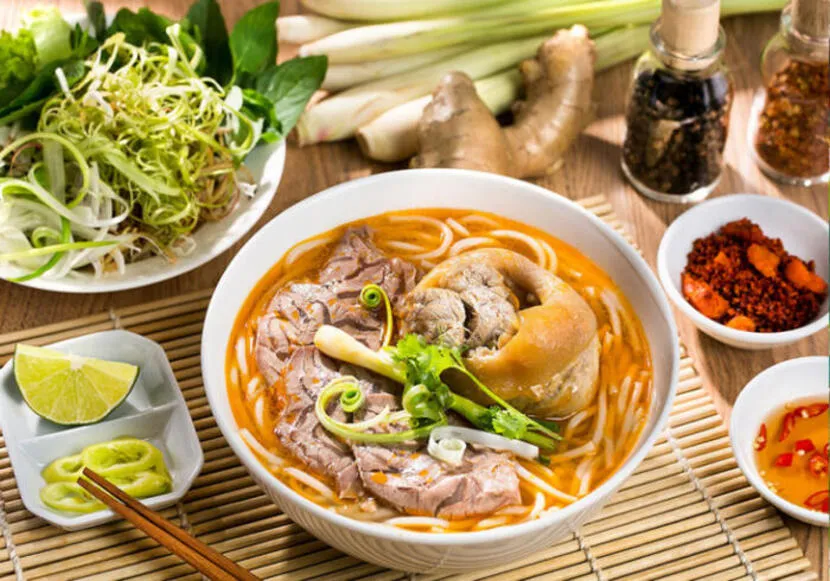
Bun Bo Hue is one of the most favourite dishes of local Hue people
First on the top list of Hue's most typical must-try dishes is definitely Hue's noodle soup with beef, a dish praised by many national and international presses as one of the most delicious Vietnamese dishes. You will find the original noodle soup with Hue beef different from those processed in other regions, especially the big vermicelli thread and the rich-flavour broth. This noodle soup contains beef; it also makes good use of pork (hocks, trotter, congealed blood cubes and loin strips). The soup is seasoned with garlic, shallots, paprika, shrimp paste, lemongrass, herbs and lemon. And while most foreigners are quite familiar with Pho (at least by its name), in Vietnam, Bun Bo Hue is known as a more hearty and delicious option. The noodle soup with Hue beef that is enjoyed in Hue is the standard flavour.
>> See more: Top 10 Delicious Vietnamese Dishes
2. Mussel Rice (Cơm Hến)
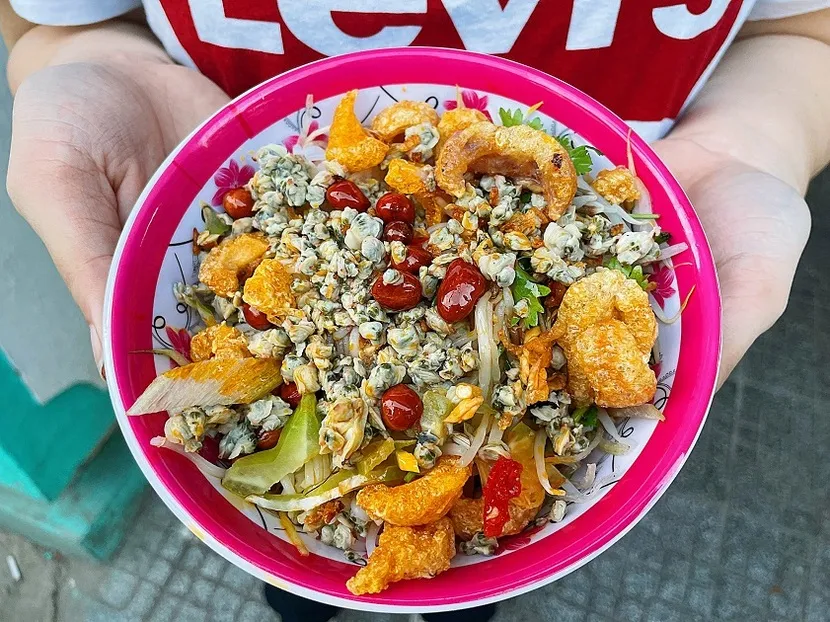
A full bowl of Mussel Rice (Cơm Hến)
Mussel rice is a dish including boiled rice and a kind of Asian mollusk. This is one of Hue's typical dishes that is not to be missed. Taste a bite of Cơm Hến, you will feel the sweetness of fried mussel, the sharp taste of ginger, the spiciness of chilli, as well as the crunchiness of herbs and soybean sprouts, combining the nutty taste of roasted peanuts. The ingredients used to prepare mussel rice are very simple but create harmony. The dish is a harmonious blend of yin and yang in both colour and flavour.
3. Grilled pork with rice noodles (Bún thịt nướng)
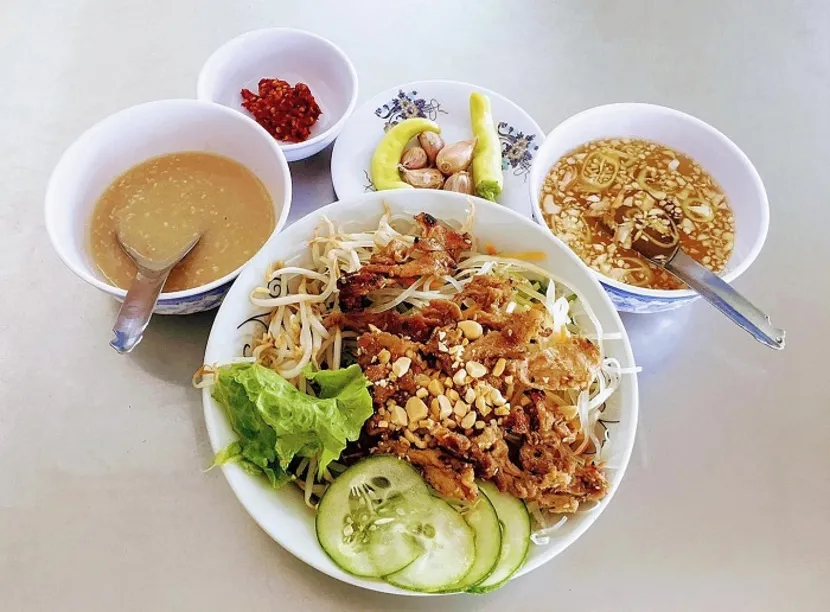
Grilled pork with rice noodles (Bún thịt nướng) eaten with peanut sauce
This is a simple dish with contrasting elements: rice noodles at room temperature and hot pork grilled, eaten with vegetables, herbs, spices, roasted peanuts, and typical Hue peanut sauce.
Bún thịt nướng is available in every corner of Vietnam, but in Hue it tastes different. The ingredients for cooking this dish are quite simple, including lean meat, pork belly, pork liver, raw vegetables, cucumber, etc. First, you put the cut meat in a large bowl and marinate it with spices such as lemongrass, garlic, pepper, fish sauce ,salt,... depending on the cook's own taste. Afterwards, the meat is placed on a griddle, grilled over charcoal. Unlike other regions, grilled pork with rice noodles in Hue is eaten with a typical sauce, which is the soul of the dish, enhancing its delicacy. The hot and absorbing grilled meat served with fragrant noodles, fresh vegetables and irresistible sauce. It is suitable to enjoy Bún thịt nướng at any time of the day.
4. Hue Cake (Bánh Huế)
Bánh Huế or Hue Cake is a term used to refer to a variety of cakes originating from the city of Hue in central Vietnam. While these cakes share common base ingredients of rice flour, the different recipes and techniques used by the local residents result in each kind of cake having its own unique flavour and characteristics.
The most popular Hue Cake includes Vietnamese crepe (bánh khoái), steamed rice cake (bánh nậm), steamed rice cake with shrimps (bánh bèo chén), sticky rice dumplings and crispy treats (bánh ram ít). It will be hard for you to ignore them during your travels in this imperial city.
Steamed rice cake (Bánh Nậm)
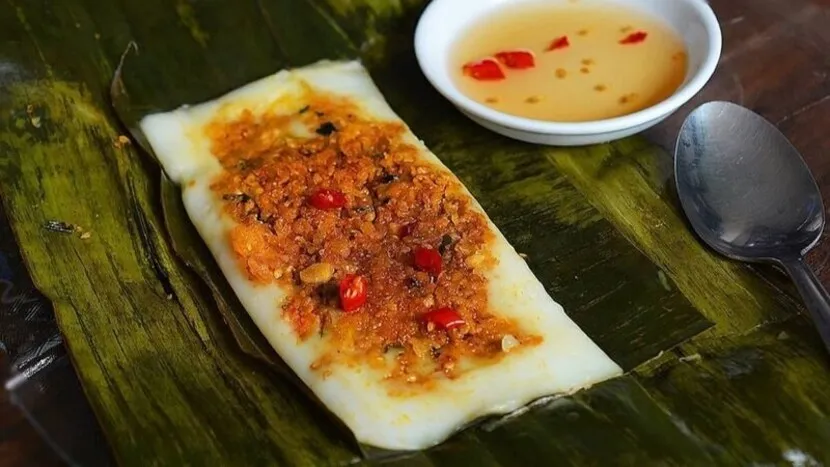
Bánh Nậm is a famous rustic dish in Hue, suitable for everyone from young to old . The dish’s texture is soft and delicate, with a slight shrimp flavour. Its ingredients are so simple and rustic, consisting of glutinous rice flour, minced shrimp, seasoned with spices and then steamed.
To make Bánh Nậm, a thin layer of the rice flour batter is spread onto a banana leaf. Then, a spoonful of the pork filling, typically seasoned with mushrooms, shallots, and various spices, is placed in the centre. The banana leaf is folded over to enclose the filling, creating a rectangular or square shape. The cakes are then steamed until cooked through.
Eating Bánh Nậm is to enjoy the quintessential taste of the Hue culinary. That is harmonious from the taste to the scent of banana leaves. The cake is soft with a hint of shrimp flavour. The piece of cake seems to melt in your mouth. In addition, there are vegetarian Bánh Nậm with green bean fillings, usually prepared for the day of the full moon or the first day of the lunar calendar.
Vietnamese crepe (Bánh khoái)
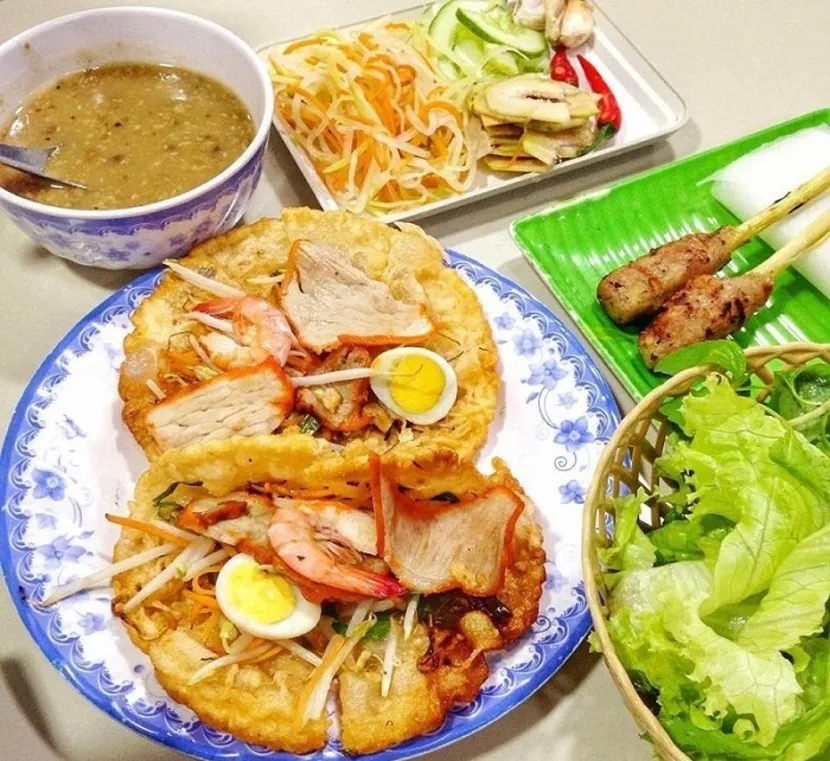
The crepe must be favoured by so many people that it is given the name Bánh Khoái. In Vietnamese, khoái means liking. Some people misunderstand it with Bánh Xèo because of their quite similar appearance and ingredients. Bánh khoái is a savoury pancake made from a batter of rice flour, water, and turmeric powder. It is typically filled with a mixture of shrimp, pork, and bean sprouts and then folded in half. Bánh khoái is often served with fresh herbs and a dipping sauce. However, the crust of Bánh Khoái is thicker than that of Bánh Xèo and it is eaten with a special sauce made from lean meat, pork liver, roasted sesame, and chopped peanuts instead of sweet and sour fish sauce.
Steamed rice cake in bowls (Bánh Bèo Chén)
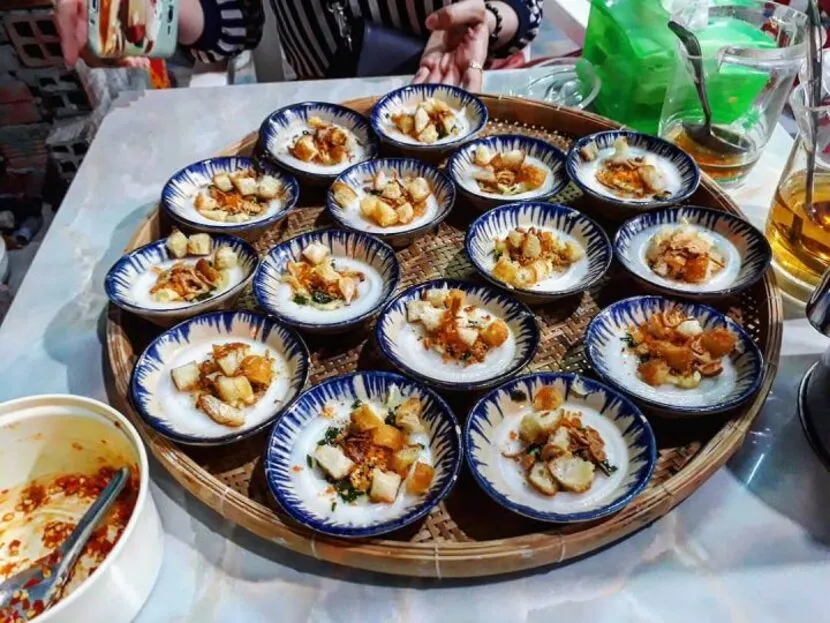
Bánh Bèo Chén is an idyllic dish of the people of Hue. The tiny cake is fragrant with rice flour and has the sweetness of shrimp mixed perfectly with the spicy fish sauce that makes diners flinch when they taste it.
This dish is not only delicious but also very charming because each cake is placed in a pretty little bowl. The white cake, attached to the small bowl, with shrimp floss, fried shallots and fat balls on top is very charming and eye-catching. The cakes are also garnished with fresh herbs like cilantro and served with a dipping sauce made from fish sauce, lime juice, sugar, garlic, and chilli.
To eat Bánh Bèo Chén, please use a spoon to scoop the cake and its whole toppings into your mouth. The combination of the soft and slightly chewy texture of the cake, the savoury toppings, and the tangy dipping sauce creates a harmonious and delicious bite.
In addition to roadside restaurants, Hue’s people often eat Bánh Bèo Chén at a random vendor in small alleys.
Sticky and crispy rice dumplings (Bánh ram ít)
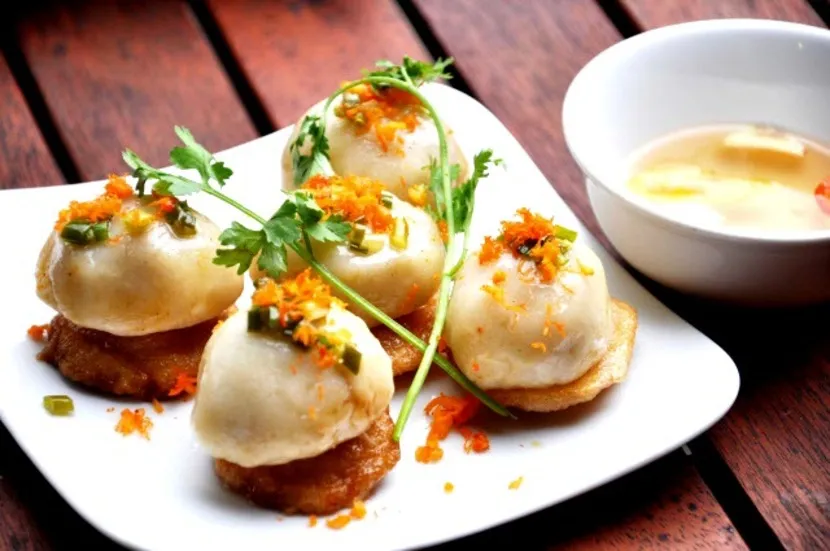
In Hue, Bánh Ram Ít is one of the most rustic dishes very familiar to people. The cake is divided into 2 parts: crispy fried dumpling on top and soft sticky rice dumpling underneath, creating a layered effect. These two flavours seem impossible to fulfil but in fact, they create a unique eating experience. Adding shrimp floss to the cake and dipping them in the sweet and sour sauce to make the cake even more flavourful. The combination of the crispy and savoury fried dumpling with the soft and sticky texture of the sticky rice dumpling creates a delightful contrast in each bite.
The cake is quite small, so when eating, you can put a whole piece of cake in your mouth.
Vietnamese tapioca dumplings (bánh bột lọc)
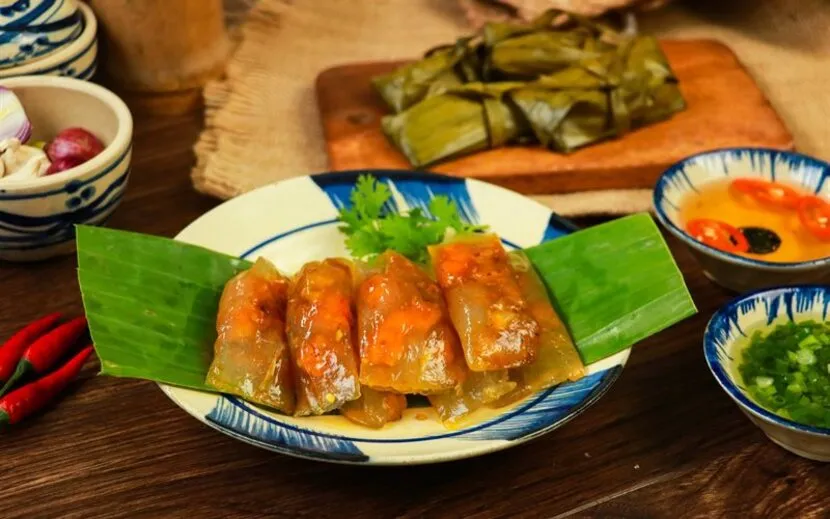
Bánh bột lọc is one of the specialties, representing the quintessential Hue cuisine. Bánh Bột Lọc is a translucent, chewy dumpling made from a combination of tapioca starch and rice flour. It is filled with seasoned shrimp or pork and then steamed. When steamed, the cake becomes translucent and has moderate toughness. The dumplings are usually served with a sweet and spicy dipping sauce. Bánh Bột Lọc has become a must-have treat for any travellers in Hue royal city.
5. Sweet Gruel (Chè Huế)
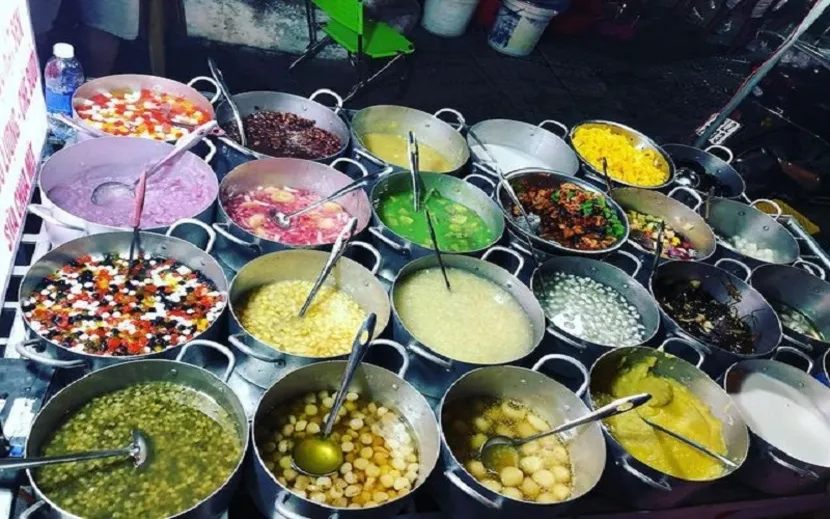
Sweet gruel can be eaten both in hot and cold style
Hue city is also known as "the capital of sweet gruel" There are more than 20 different kinds of Chè, especially the real ones. Therefore, sweet soup certainly stands in the list of Hue's most typical delicious dishes not to be missed.
The specific ingredients and variations of sweet gruel can vary, but some common components include mung beans, black-eyed peas, lotus seeds, tapioca pearls, agar jelly, and various tropical fruits like jackfruit and lychee. The dessert is typically served in bowls or glasses, and additional toppings such as crushed ice, coconut cream, roasted peanuts, and sesame seeds may be added for added texture and flavour. Each spoonful of Chè Huế offers a combination of textures, from creamy to chewy to crunchy, along with a delightful sweetness.
Chè Huế can be served hot or cold, depending on personal preference and the weather. It is often enjoyed as a refreshing treat during hot summer months but can also be served warm during colder seasons. It is sold everywhere in Hue, you can choose any vendor in the streets or markets for your first time try.
Hue foods have something really unique, that is, an unmistakable charm. If you have the opportunity to visit this land, don't forget to taste the quintessential culinary delights of the ancient capital. Hue awaits, ready to enchant you with its culinary treasures and unforgettable experiences.
For other interesting activities in Hue imperial city, you can see more:
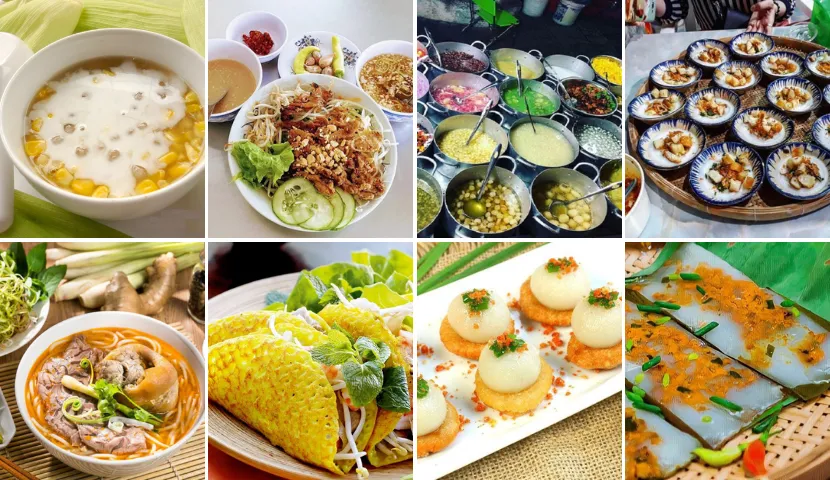








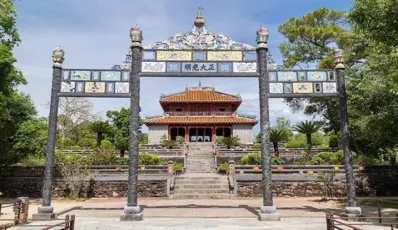

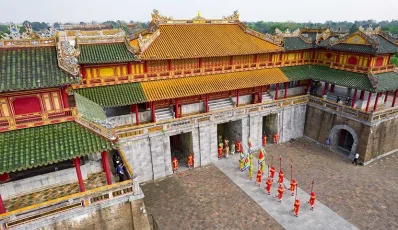









 TRAVELERS' CHOICE 2026
TRAVELERS' CHOICE 2026 


